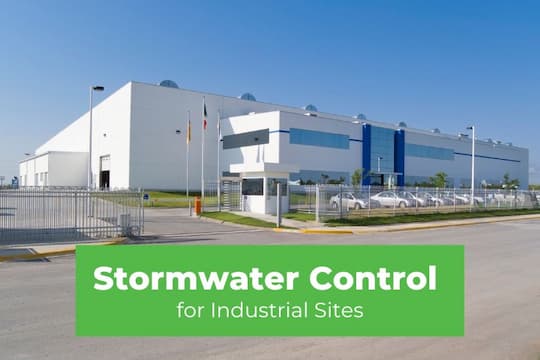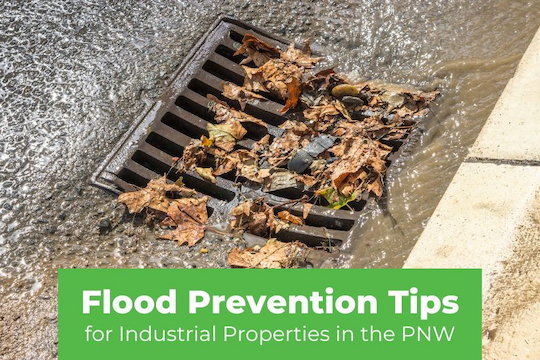Stormwater management is a crucial component of environmental stewardship in industrial settings. Uncontrolled runoff can lead to significant ecological and regulatory challenges. Industrial facilities often have extensive impervious surfaces, such as rooftops, parking lots, and storage areas, which prevent water from infiltrating the ground. The larger these facilities are, the greater the stormwater challenges they face in industrial settings.
When rainwater and snowmelt flow over these surfaces, they pick up pollutants, including oils, chemicals, heavy metals, and sediments. Managing stormwater runoff is essential to protect water quality, comply with regulations, and minimize environmental impact. It is also a key aspect of operating responsibly within the local community. So, how do industrial facilities manage these challenges effectively?
Identifying Key Challenges
We have identified five primary stormwater challenges in industrial settings, regardless of the facility size:
- Pollution: Industrial sites often contain pollutants such as hydrocarbons, heavy metals, and hazardous chemicals. Rain washes these contaminants into the stormwater system, potentially degrading water quality in nearby rivers or lakes. Pollutants like oil, grease, and metals can persist in the environment and accumulate in the food chain. This accumulation poses significant risks to wildlife and humans alike, potentially causing health issues and impacting local ecosystems.
- Compliance: Due to these hazards, stringent stormwater regulations require industrial sites to protect the community. Regulatory frameworks such as the U.S. Environmental Protection Agency’s (EPA) National Pollutant Discharge Elimination System (NPDES) enforce these rules. Failure to comply can result in significant fines, legal action, reputational damage, and even temporary shutdowns until issues are resolved. Compliance also involves regular reporting and documentation to demonstrate adherence to environmental standards, which can be resource-intensive but is essential for maintaining a good standing with regulatory bodies.
- Flooding: Impervious surfaces increase the volume and velocity of runoff, which can cause flooding. This can disrupt operations, damage property, and pose safety risks. Flooding can also lead to the contamination of water supplies and further spread pollutants. Managing flood risks involves physical infrastructure, planning, and emergency response strategies to protect employees and assets.
- Erosion: Uncontrolled stormwater can erode landscapes, damage infrastructure, and contribute to sediment pollution in water bodies. Erosion can undermine the structural integrity of buildings and roads, lead to costly repairs, and increase sediment loads in streams and rivers, impacting aquatic habitats and water quality. This issue is particularly pressing for facilities located near natural water bodies or in areas with unstable soils.
- Expense: Ineffective stormwater management can be costly. Expenses related to flood damage, regulatory fines, environmental cleanup, and the implementation of remedial measures can be substantial. Investing in preventive measures and regular maintenance can significantly reduce these costs over time, but the initial investment can be a barrier for some companies. Nevertheless, the long-term savings and benefits to public health and the environment often justify these expenditures.

In addition to these challenges, deteriorating infrastructure, broken components, or neglected maintenance can exacerbate stormwater challenges in industrial settings. For example, regular maintenance of stormwater vaults is essential to maintain structural integrity and manage sediment levels. Wet vault cleaning addresses floating and submerged debris and residue, which, if left unaddressed, could lead to blockages and failures in the stormwater management system.
Addressing Stormwater Management Challenges in Industrial Settings
Effective stormwater management requires a combination of robust infrastructure and best management practices (BMPs). Here are some strategies to consider:
1. Implement a Stormwater Pollution Prevention Plan (SWPPP)
All industrial properties in the state of Washington must implement a stormwater pollution prevention plan (SWPPP) developed by qualified personnel. The SWPPP will specify the appropriate BMPs to comply with Washington’s Industrial Stormwater General Permit (ISGP). In addition, the SWPPP should include:
- A site map
- Description of facility and activities
- An inventory of materials that could contribute to stormwater pollution
- The designated individuals responsible for developing and managing the SWPPP
- BMPs including source control BMPs, good housekeeping, preventative maintenance, spill prevention and emergency cleanup, employee training, inspections, and recordkeeping, and measures to identify and eliminate illicit discharges
For more information on developing or managing your SWPP, current DOE regulations can be found here. You can also reach out to the team at CatchAll Environmental, and we will be happy to help.
2. Prevent Contamination at the Source

Keeping hazardous materials away from stormwater is a fundamental preventive measure. This includes proper storage of chemicals in covered containers, immediate cleanup of spills, and maintaining clean industrial areas. Storage areas should be located away from stormwater flow paths to prevent accidental contamination. Many companies have developed comprehensive policies and procedures for chemical storage and spill response, which are typically included in employee handbooks or operations manuals. Designating specific staff members to manage storage and cleanup activities is also a common practice, ensuring accountability and prompt action in the event of a spill.
Additionally, implementing spill containment systems and secondary containment measures can provide extra protection against accidental releases. These systems are particularly important in areas where large quantities of hazardous materials are stored or handled. Routine training for employees on spill prevention and response is also crucial to maintaining a culture of safety and environmental responsibility.
3. Implement and Maintain Essential Infrastructure
Beyond relocating contaminants, it is crucial to have appropriate infrastructure to effectively manage stormwater runoff. Here are some key components:
- Catch Basins and Detention Vaults: These structures capture and hold stormwater runoff, allowing for gradual release to prevent flooding and erosion. While storm ponds hold water permanently, dry ponds temporarily retain stormwater and release it at a controlled rate. Proper sizing and placement of these structures are essential to ensure they can handle the expected volume of runoff without overflowing or causing downstream flooding.
- Oil-Water Separators: These devices separate oil and other hydrocarbons from stormwater runoff, allowing for safe discharge. Regular cleaning is necessary to manage the accumulation of pollutants. Failure to maintain these systems can lead to significant environmental harm and regulatory violations. Advanced models with automatic oil removal features can improve efficiency and reduce the need for manual intervention.
- Permeable Pavement: This type of pavement filters stormwater through its surface and into the ground, reducing runoff volume. It is particularly effective in parking lots, walkways, and low-traffic areas. Permeable pavement helps manage stormwater and reduces the heat island effect in urban areas by allowing water to cool the pavement surface. However, regular maintenance is required to prevent clogging and ensure long-term functionality.
- Green Roofs: Suitable for warehouses or office buildings, green roofs are vegetated systems that absorb rainwater and reduce runoff. Routine care and maintenance are required for consistent performance. Inspections should be conducted at least twice a year, in spring and fall, and after severe weather events. Maintenance activities include weeding, plant replacement, pruning, and irrigation during dry periods. If fertilizing, use slow-release, low-nitrogen products and opt for organic pesticides to maintain the ecological benefits of the green roof. Green roofs also provide additional insulation, reducing energy costs for heating and cooling.
In addition to these measures, installing rain gardens and bioswales can further enhance stormwater management. These landscape elements use native plants and natural filtration to absorb and filter stormwater, reducing runoff and improving water quality.
4. Regular Maintenance of Stormwater Infrastructure

Once installed, stormwater infrastructure requires regular maintenance to remain effective. For example, filtration systems, such as sand or cartridge filters, are essential for removing suspended solids, oils, and other pollutants from stormwater. These systems must be cleaned and maintained routinely to function correctly. Neglecting maintenance can lead to system failures, environmental violations, and increased costs for emergency repairs.
Preventive stormwater maintenance is vital for addressing many stormwater challenges in industrial settings. Enlisting experts to clean catch basins, inspect oil-water separators, and maintain filtration systems can ensure long-term system effectiveness, even during periods of light rainfall. Many clients find it beneficial to schedule annual maintenance appointments, starting with a comprehensive inspection followed by necessary cleaning. These inspections also help budget for future repairs, ensuring that stormwater management infrastructure remains in good condition.
Regular maintenance activities should also include checking for signs of wear and tear, corrosion, and damage to pipes, valves, and other components. Early detection of issues can prevent minor problems from escalating into major failures that could disrupt operations and cause environmental harm.
Partnering for Effective Industrial Stormwater Management

Stormwater management in industrial settings involves various challenges, from pollution control and regulatory compliance to flood prevention and ecosystem protection. Industrial facilities can effectively manage stormwater and minimize environmental impact by implementing source control measures, structural BMPs, advanced treatment technologies, and rigorous monitoring and maintenance practices.
Industrial facilities need a proactive approach to stormwater management and an experienced partner to handle this critical aspect of their stormwater pollution prevention plan. CatchAll Environmental offers routine maintenance and troubleshooting services, including video pipe inspections, pollutant source control oversight, and storm pond remediation. We tailor our approach to meet your unique needs.
By choosing CatchAll, you gain access to a team of experts dedicated to helping you navigate the complexities of stormwater management. Our customized solutions are designed to address your specific challenges, ensure compliance with regulations, and protect the environment. Reach out to us today to schedule an inspection and discover how we can support your stormwater management efforts!













